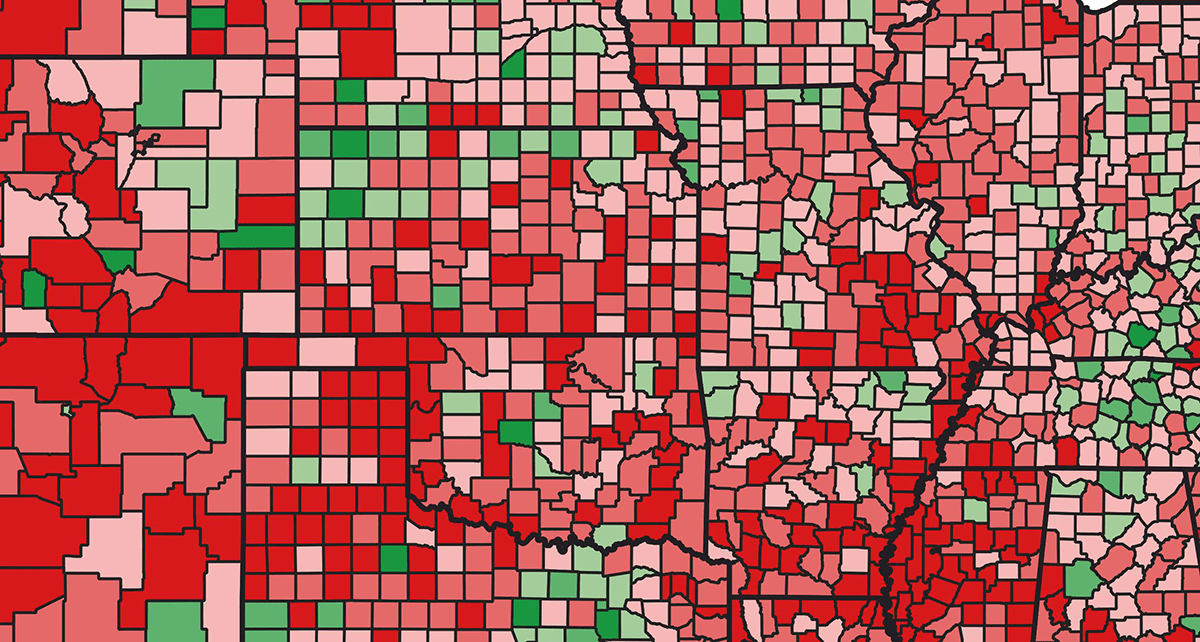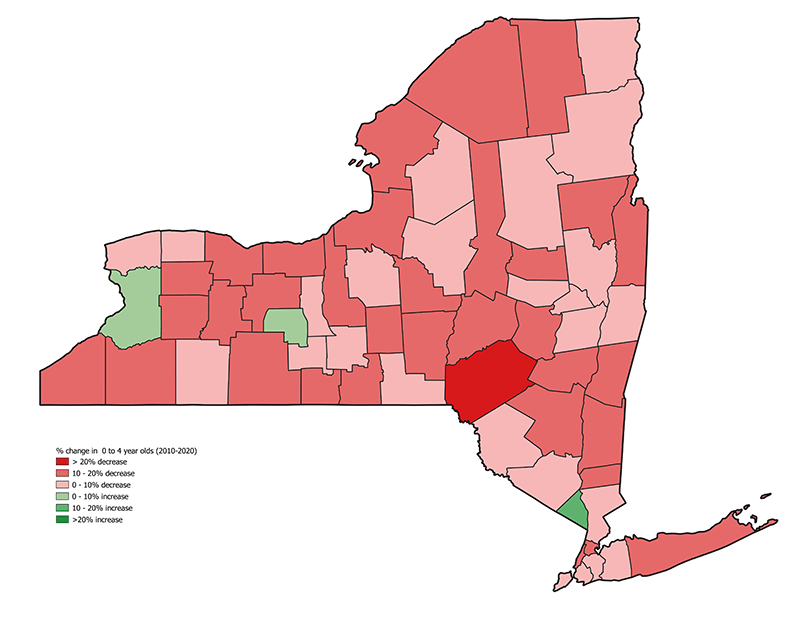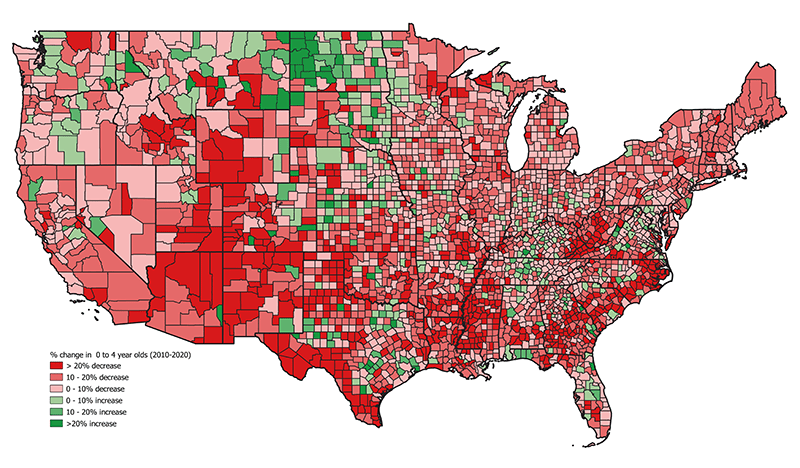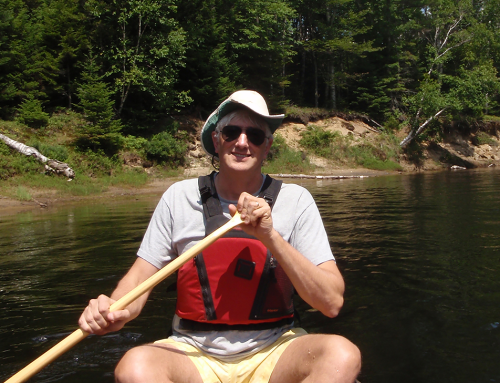Population trends in the Adirondack Park are consistent with the vast majority of communities across the United States.
The US Census recently released more in-depth 2020 population data with full age ranges and an assortment of other demographic data. The 2020 Census was historically late, given the COVID-19 pandemic and other administrative problems. Comparing the 2020 data with 2010 gives us a window into the realities and challenges for communities throughout the Adirondack Park, Upstate New York, and Rural America.
In 2020, the US Census found that New York State grew by 4.2%, gaining over 800,000 new people, increasing from 19,378,102 to 20,201,249. This followed a decade of official Census estimates about population loss in New York that proved to be false. This gain was also against a trend where half of all counties across the U.S. lost population, something that had never happened before in American history.
Population growth 2010 to 2020 in New York was not evenly distributed as 23 counties saw gains and 39 counties experienced losses. The 10 Downstate counties in the lower Hudson Valley (Orange, Rockland, Westchester), New York City (New York, Richmond, Bronx, Queens, Kings), and the Long Island (Nassau, Suffolk) all gained, reaping 828,352 new residents between them. The five counties in New York City alone gained 628,682 new residents. Simply put, the state’s population growth was downstate. The other 52 counties Upstate gained a combined net of 5,000 new residents.
The new 2020 US Census data provided age range data, which lets us look at changes in the numbers of children, young adults, and older residents throughout New York. Starting with the state’s youngest, the number of New Yorkers 0 to 4 years old across New York dropped from 1,155,822 to 1,060,610. Similarly, the number of 5 to 17-year-olds also dropped from 3,169,107 to 3,052,504. In sum, there were 211,815 fewer children in New York State at ages 17 years old and younger in 2020 than there were in 2010.
Many see the declining numbers of children in the population as a uniquely Adirondack Park problem, but the reality is that this is an issue throughout most of Upstate New York and beyond. The 12 counties where the Adirondack Park is located had a total population in 2020 of 1,013,109, of which over 85% live outside the Blue Line, in places like Plattsburgh, Glens Falls, Saratoga Springs, Johnstown, and Utica among other places. In the Park counties, the number of residents 0 to 4 years old dropped from 55,915 to 50,419 and the 5 to 17-year-old population dropped from 164,303 to 153,008, a change of over 16,000, an 8% drop. All 12 Adirondack counties saw population drops among resident kids.
It’s important to put this loss of 16,000 North Country kids in context. Only three counties out of New York’s 62 counties saw growth of 0 to 4-year-old residents (see map below). Rockland County jumped by over 11%, Erie County grew by 2%, and Yates County grew by 1.2%. There are local trends in each of these places driving these pockets of growth. The story was much the same for the 5 to 17-year-old cohort. Just four out of 62 counties saw an increase in their 5 to 17-year-old residents. In New York City, Kings County (Brooklyn) grew by 2.3% and Queens County grew by 1.3%, adding nearly 14,000 kids. Orange County grew by 1.6% and Rockland County made a big jump by 13.2%, some 8,400 kids.
In a national context, the story is much the same (see map below). The number of 0 to 4-year-old Americans decreased by 1.9 million kids from 2010 to 2020, as 86% of U.S. counties (some 2,783 out of 3,221) experienced declines in young children. The 5 to 17-year-old cohort was different. The number in the 5 to 17-year-old cohort actually increased by just under 500,000 kids, yet 66% of all counties (2,135) in the U.S. saw declines in children in this age group.
With better than two-thirds of the counties in the U.S. seeing losses in the number of children in their populations, it’s important to note that these places are all well beyond the Blue Line by hundreds or thousands of miles so the reason for this widespread population loss cannot be blamed on Adirondack Park Agency land use controls or forever wild Forest Preserve public land base. Smaller families and delayed parenting until older ages is the norm in American life today and tens of thousands of small communities are being forced to adjust to that reality.
While the number of children 0 to 17 in New York fell in 2010 to 2020, the number of adult New Yorkers of childbearing age, from 18 to 44 years old, actually grew. This growth stems from larger cohorts of kids that aged into adults from 2010 to 2020 and from immigration from abroad and other states. In New York, adults of childbearing age grew from 7,252,871 to 7,456,433. The growth of adults of childbearing age by 200,000 contrasts with the decrease in children by 200,000. The quandary for those seeking to boost their local populations in Upstate New York communities is that adult New Yorkers at ages who can reproduce are choosing to spawn fewer and fewer offspring.
Across the U.S., it’s a similar tale. As discussed above, the population of children in the U.S. 0 to 17 years old decreased by about 1.4 million from 2010 to 2020. During these same years, the number of adults of childbearing age in the U.S. grew by almost 5.2 million. Like New Yorkers of childbearing age, Americans of childbearing age across the country are choosing to have fewer and fewer kids.
While the total number of Americans 18 to 44 years old grew from 2010 to 2020, most areas in the U.S. lost population among people of these ages. 64% of U.S. counties experienced population losses among 35 to 44 year olds, while 50% of U.S. counties saw losses among 25 to 34 year olds, and 65% of U.S. counties saw losses among 18 to 24 year olds. North Country counties were a mix between losses and gains among 18 to 24 year olds, but all 12 counties saw losses among 25 to 34 year olds and 35 to 44 year olds.
Those who are interested in population recruitment to increase the population of their communities not only need to figure out how to attract adults of childbearing age to relocate to their communities, but they also have to figure out how to get them to reproduce.
There was a lot of buzz recently that Millennials are now the largest generational cohort alive in the U.S., topping the Baby Boom generation, the long dominant cohort born from 1945 to 1965 that is aging and starting to decline. That said, the population of older Americans grew significantly from 2010 to 2020, and it will grow even more from 2020 to 2030, as the youngest Baby Boomers reach 65 years old. In 2020, the Census found that Americans at 65 years old and older grew by over 15.7 million people from its 2010 level. While many of these Americans age in place, many also move to various retirement destinations throughout the country.
The 12 Adirondack Park counties constitute a geographic area that not only has an older population, where many are choosing to age in place, but it is also a place that attracts retirees. In the 12 Adirondack Park counties, the population 65 years old and older grew by over 45,000 people from 2010 to 2020, from 154,607 to 200,655, and is now fully 20% of the area’s population. Almost all of that growth was with people ages 65 to 84, the prime and active retired population. This is a combination of Baby Boomers, which had been the largest generation in American history, aging in place, and their compadres who move to the North Country for small town life with easy and abundant access to all kinds of outdoor recreation activities and stunning scenic beauty. Every North Country county gained people after age 65, from over 14,000 in Saratoga County to 3,900 in Warren to 500 in Hamilton to 3,200 in Clinton and over 1,600 in Essex.
The population in the 12 Adirondack Park counties over 85 years old was largely flat from 2010 to 2020, gaining just 500, while the population of residents 100 years old and older grew from 180 to 326.
The 20% of the population in the 12 Adirondack Park counties that is 65 years old or older is higher than the U.S. rate of 16.9% and the New York State rate of 16.8%, but there are many other scenic/resort/tourist areas in the country that attract people at age 65 years old or older as retirement destinations and are similarly skewed like many North Country communities. If North Country communities did not attract retirees, we’d be the same rate as the state and national averages.
While new retirees are a replenishing pool of sorts, with new retirees arriving each year, the one issue with older residents is that they eventually die. As I’ve written before, the key challenges for the North Country to boost its population is to figure out how to get adults of childbearing age to have more kids and how to stop older residents from dying, which are tough tasks.
In the North Country, fewer kids 0 to 4 years old means fewer kids in 10 years who will be 10 to 14 years old to populate local schools. This scenario is playing out not just here but in 86% of the counties in the U.S. Fewer 10-year-old kids in the North Country today means fewer kids who will graduate from High School here. This scenario is not just playing out here but is playing out in 66% of the counties in the country today.
Fewer kids who graduate from High School here mean fewer adults who choose to stay and make their lives in the North Country. This trend, combined with an older population that is getting older, is not just an Adirondack Park story or an Upstate New York story, it’s the story across vast geographies of America in 2024. The North Country has lots of company at this point in time as we share our population reality with the overwhelming majority of the U.S.








